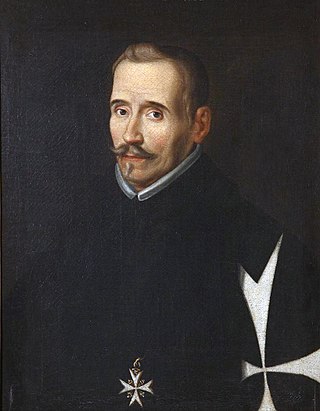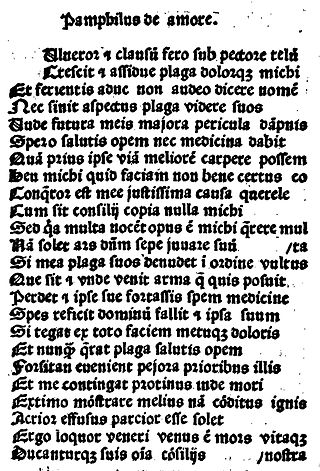Related Research Articles

Giovanni Boccaccio was an Italian writer, poet, correspondent of Petrarch, and an important Renaissance humanist. Born in the town of Certaldo, he became so well known as a writer that he was sometimes simply known as "the Certaldese" and one of the most important figures in the European literary panorama of the fourteenth century. Some scholars define him as the greatest European prose writer of his time, a versatile writer who amalgamated different literary trends and genres, making them converge in original works, thanks to a creative activity exercised under the banner of experimentalism.

This article contains summaries and commentaries of the 100 stories within Giovanni Boccaccio's The Decameron.

Pedro González de Mendoza was a Spanish cardinal, statesman and lawyer. He served on the council of King Enrique IV of Castile and in 1467 fought for him at the Second Battle of Olmedo. In 1468 he was named bishop of Sigüenza and in 1473 he became cardinal and archbishop of Seville and appointed chancellor of Castile.

Íñigo López de Mendoza, 1st Marquess of Santillana was a Castilian politician and poet who held an important position in society and literature during the reign of John II of Castile.

Henry IV of Castile, nicknamed the Impotent, was King of Castile and León and the last of the weak late-medieval kings of Castile and León. During Henry's reign, the nobles became more powerful and the nation became less centralised.

Álvaro de Luna y Fernández de Jarava, was a Castilian statesman, favourite of John II of Castile. He served as Constable of Castile and as Grand Master of the Order of Santiago. He earned great influence in the Crown's affairs in the wake of his support to John II against the so-called Infantes of Aragon. Once he lost the protection of the monarch, he was executed in Valladolid in 1453.

John, Prince of Asturias and Girona, was the only son of King Ferdinand II of Aragon and Queen Isabella I of Castile, and heir apparent to both their thrones for nearly his entire life.

Fuenteovejuna is a play by the Spanish playwright Lope de Vega. First published in Madrid in 1619, as part of Docena Parte de las Comedias de Lope de Vega Carpio, the play is believed to have been written between 1612 and 1614. The play is based upon a historical incident that took place in the village of Fuenteovejuna in Castile, in 1476. While under the command of the Order of Calatrava, a commander, Fernán Gómez de Guzmán, mistreated the villagers, who banded together and killed him. When a magistrate sent by King Ferdinand II of Aragon arrived at the village to investigate, the villagers, even under the pain of torture, responded only by saying "Fuenteovejuna did it."
Don PeroLópez de Ayala (1332–1407) was a Castilian statesman, historian, poet, chronicler, chancellor, and courtier.

"Il Filostrato" is a poem by the Italian writer Giovanni Boccaccio, and the inspiration for Geoffrey Chaucer's Troilus and Criseyde and, through Chaucer, the Shakespeare play Troilus and Cressida. It is itself loosely based on Le Roman de Troie, by 12th-century poet Benoît de Sainte-Maure.

Topacio is a 1984 Venezuelan telenovela produced by RCTV based on the telenovela by Delia Fiallo Esmeralda produced by rival network Venevisión in 1970. It starred Grecia Colmenares and Víctor Cámara and with the antagonistic participations of Nohely Arteaga, Alberto Marín and Chony Fuentes.
Women Pleased is a late Jacobean era stage play, a tragicomedy by John Fletcher that was originally published in the first Beaumont and Fletcher folio of 1647.

Swetnam the Woman-Hater Arraigned by Women is a Jacobean era stage play, an anonymous comedy that was part of a controversy of the 1615–20 period.

The Decameron, subtitled Prince Galehaut and sometimes nicknamed l'Umana commedia, is a collection of short stories by the 14th-century Italian author Giovanni Boccaccio (1313–1375). The book is structured as a frame story containing 100 tales told by a group of seven young women and three young men; they shelter in a secluded villa just outside Florence in order to escape the Black Death, which was afflicting the city. Boccaccio probably conceived of the Decameron after the epidemic of 1348, and completed it by 1353. The various tales of love in The Decameron range from the erotic to the tragic. Tales of wit, practical jokes, and life lessons contribute to the mosaic. In addition to its literary value and widespread influence, it provides a document of life at the time. Written in the vernacular of the Florentine language, it is considered a masterpiece of classical early Italian prose.

The Visitors is an opera in three acts and a prologue composed by Carlos Chávez to an English-language libretto by the American poet Chester Kallman. The work was Chávez's only opera. Its first version, with the title Panfilo and Lauretta, premiered in New York City in 1957. The final version with the title The Visitors was premiered in Guanajuato City, Mexico, in 1999, twenty years after the composer's death. The story is set in 14th century Tuscany during the time of the Black Death. The libretto uses the device of a play within a play to reflect and intensify the relationships between the protagonists, who in this case are loosely based on characters in The Decameron.

Elegia di Madonna Fiammetta, or The Elegy of Lady Fiammetta in English, is a novel by the Italian writer Giovanni Boccaccio, probably written between 1343 and 1344. Written in the form of a first-person confessional monologue, it describes the protagonist, Fiammetta's, passion for Panfilo, a Florentine merchant, and takes place in Naples. It has been characterised as the first psychological novel in Western literature. It consists of a prologue and nine chapters.

Isabella I, also called Isabella the Catholic, was Queen of Castile from 1474 until her death in 1504. She was also Queen of Aragon from 1479 until her death as the wife of King Ferdinand II. Reigning together over a dynastically unified Spain, Isabella and Ferdinand are known as the Catholic Monarchs.

El Señor de los Cielos is an American crime drama television series created by Luis Zelkowicz, based on an original idea by Mariano Calasso, and Andrés López. It premiered on Telemundo on 15 April 2013. The series is based on the life and work of Amado Carrillo Fuentes, the former leader of the Juarez Cartel. It stars Rafael Amaya as the titular character, Aurelio Casillas.

Reina de corazones is an American telenovela produced by Joshua Mintz and Aurelio Valcárcel Carroll for Telemundo.

Pamphilus de amore is a 780-line, 12th-century Latin comedic play, probably composed in France, but possibly Spain. It was "one of the most influential and important of the many pseudo-Ovidian productions concerning the 'arts of Love'" in medieval Europe, and "the most famous and influential of the medieval elegiac comedies, especially in Spain". The protagonists are Pamphilus and Galatea, with Pamphilus seeking to woo her through a procuress.
References
- Barbara Matulka, Novels of Juan de Flores and their european diffusion: a study in comparative literature, Slatkine, 1974.
- Gustave Reynier, Le Roman sentimental avant "l'Astrée", Paris: Armand Colin, 1971.
- E. Michael Gerli, ed., Medieval Iberia: An Encyclopedia, article "Flores, Juan de" by Joseph J. Gwara, Routledge, 2003, pp. 336–337. ISBN 978-0415939188
- Luis F. López González, “Mirabella’s Deadly Gaze: The Force that Destabilizes the State’s Power in Grisel y Mirabella.” Viator 48.1 (2017): 145–160.